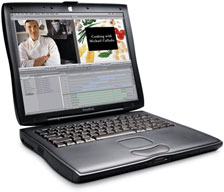Collection Spotlight
The Enduring Value of the Pismo PowerBook
- 2009.07.27 - Tip Jar
When Steve Jobs stood in front of the crowd at Macworld San Francisco on January 9, 2001 and revealed the PowerBook G4 (then referred to as the "PowerBook G4 Titanium" and soon nicknamed "TiBook"), he said:
"We have the most powerful notebooks in the world. But they have the sex. We want both - the power and the sex."
I disagree. Sure, you find a few advocates of the Titanium PowerBook design. It was revolutionary: thin (just 1"), light, widescreen, a slot-load DVD-ROM drive. It set in motion the design of Apple's professional line of notebooks right up to the Unibody models.

The Pismo PowerBook.
However, for someone looking for an older PowerBook that can still hold it's own, looks modern, and is durable, the PowerBook G3 Pismo - the model the Titanium PowerBook replaced - is the way to go.
TiBook Shortcomings vs. Pismo
The problem with Titanium PowerBooks is that they lack three things: durability, expandability, and easy access to the internals - all of which are high watermark features in my choice of notebooks. Each one detracts from my decision to purchase a TiBook.
Apple has gotten better lately. The Unibody MacBook Pros are pretty close to the perfect notebook for me. On these modern models, there is even easy access to some of the components.
On the subject of durability, the Pismo is right up there with the Panasonic Toughbooks and IBM/Lenovo ThinkPads. It is wrapped in a sturdy black plastic case, which is not thick by any measure (1.7"), but is good quality plastic. The ports are covered by a sturdy port door, in comparison to the flimsy little thing on older PowerBooks.

There's a sturdy door to protect the ports on the back of the Pismo
PowerBook.
To top it all off, the center of the machine on the top and bottom case is wrapped in a rubber-like material. On the WallStreets, this was actually rubber and wore away easily, but on the Lombard and Pismo PowerBooks, it's got rigidity to it.
Very Expandable
As far as expandability goes, the Pismo PowerBook is bested only by the venerable PowerBook 1400. It includes everything the 1400 did except for the internal expansion slot, book covers, and a second PCMCIA/PC Card card slot, but it adds a second battery bay, an internal AirPort Card slot, and the PC Card slot is now CardBus slot.
The expansion bay on the right can hold a DVD-ROM drive (default), or the module can be upgraded to house a CD-RW, a Combo drive, or a SuperDrive. In addition, it can also house a second battery (great for long plane rides or all-day road warriors), and it can even hold a second hard drive, though these modules are now rare. Sadly, the left bay can only house a battery (unlike the WallStreet, which could hold a floppy or hard drive on the left). The drive bay is hot swappable, which works like a charm in Mac OS 9, though I have seen it KO OS X once - but that was version 10.0. It works fine under 10.4 "Tiger".
There is a whole world of expansion inside, too. You can add AirPort, which I find an invaluable feature, and 802.11b WiFi is very fast. Like almost every Mac, RAM is expandable - to a whopping 1 GB - and the hard drive can be upgraded to 120 GB.
This was the last Apple laptop with an upgradable CPU, and manufacturers have upgrades to make this a beast running up to 900 MHz on the G3 side (although this chip is no longer made and has some major heat issues) or 550 MHz on the G4 side. It's a tough decision on which one to get. On one hand, you can run Mac OS X 10.5 "Leopard" on your Pismo with a G4. On the other hand, a 900 MHz G3 make an ultrafast Tiger machine. Either way, it will cost you $300.
The RAM, the CPU, the hard drive, and the AirPort Card are all easy upgrades. Lift up the keyboard and remove 5 screws to get to the hard drive, AirPort Card, and upper RAM slot. Only 7 screws to get to the CPU card and lower RAM slot.
In comparison, just to get the bottom case off the TiBook, in order to access the hard drive and AirPort Card, you need to remove over a dozen screws and the case bottom. Not fun, and quite time consuming.
I am not going to stick with the G3 forever. It was a fine chip, but it's really past its prime, even for me. When the unibodies become low-end, I might think of purchasing one.
But for now, when I need a used Apple notebook, Pismo is the way to
go, with prices starting
at about $300. ![]()
Join us on Facebook, follow us on Twitter or Google+, or subscribe to our RSS news feed
If you find Leo's articles helpful, please consider making a donation to his tip jar.
Today's Links
- Mac of the Day: Motorola StarMax 3000, introduced 1999.09.07. This inexpensive clone used lots of off-the-shelf parts.
- Support Low End Mac
Recent Content
About LEM Support Usage Privacy Contact
Follow Low End Mac on Twitter
Join Low End Mac on Facebook
Favorite Sites
MacSurfer
Cult of Mac
Shrine of Apple
MacInTouch
MyAppleMenu
InfoMac
The Mac Observer
Accelerate Your Mac
RetroMacCast
The Vintage Mac Museum
Deal Brothers
DealMac
Mac2Sell
Mac Driver Museum
JAG's House
System 6 Heaven
System 7 Today
the pickle's Low-End Mac FAQ
Affiliates
Amazon.com
The iTunes Store
PC Connection Express
Macgo Blu-ray Player
Parallels Desktop for Mac
eBay

